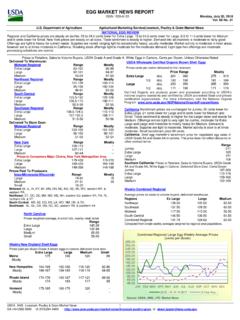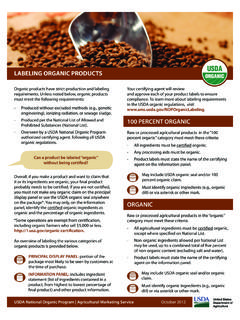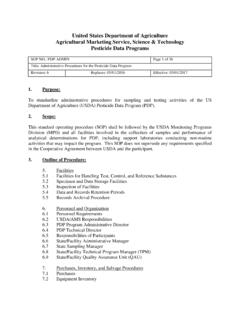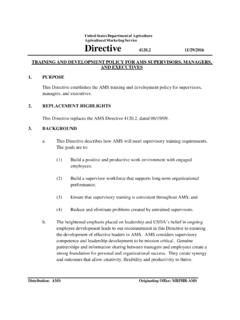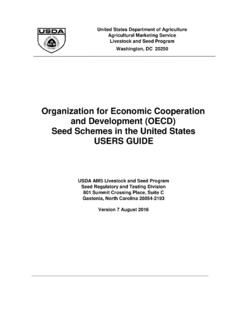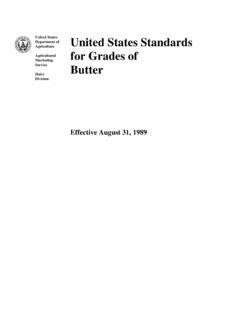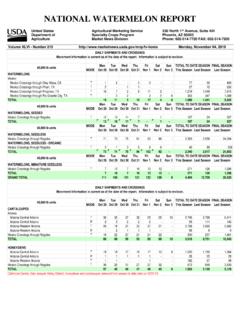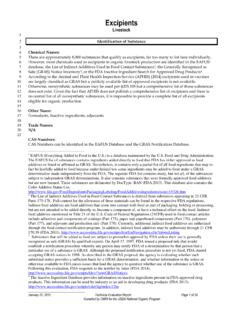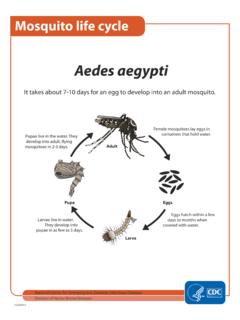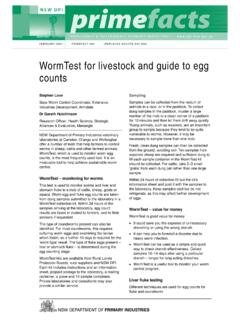Transcription of Egg Markets Overview - Agricultural Marketing Service
1 Egg Markets Overview A weekly publication of the USDA AMS Livestock and Poultry Program, Agricultural Analytics Division October 16, 2020. Wholesale prices for cartoned shell eggs held steady through the week as offerings and Loose Shell Egg, Large, White, National Index ( dock, cents per dozen) 2018 2019 2020. supplies reach equilibrium and demand moderates from recent levels. Retail promotional 270. activity is up sharply and uncharacteristically this week compared to past years which could 225. be signaling a serious of aggressive campaigns leading up to Thanksgiving. Trading is 180. moderate. The market for loose eggs saw daily price declines as offerings finally began to outpace demand and supplies became more than adequate. Trading is slow to moderate. 135. Prices for national trading of trucklot quantities of graded, loose, White Large shell eggs 90. ended the week decreased 15% (from $ to $ per dozen) with a weak steady undertone.
2 The wholesale price on the New York market for Large cartoned shell eggs 45. delivered to retailers held steady at $ per dozen with a steady undertone. The Midwest 0. 1 2 3 4 5 6 7 8 9 10 11 12 13 14 15 16 17 18 19 20 21 22 23 24 25 26 27 28 29 30 31 32 33 34 35 36 37 38 39 40 41 42 43 44 45 46 47 48 49 50 51 52. wholesale price for Large, white, shell eggs delivered to warehouses increased 7% (from Source: USDA AMS L&P Agricultural Analytics week $ to $ per dozen) with a weakening undertone into next week. This week, prices paid to producers in the Midwest for Large shell eggs are unchanged at $ per dozen. The California benchmark for Large shell eggs was up 9% (from $ to $ per dozen). and trade sentiment is for steady prices into next week. Delivered prices on the California Table Egg Demand (Shell Egg Demand Index) 2018 2019 2020. wholesale loose egg market decreased 7% (from $ to $ per dozen) and the 40.
3 Undertone is weak. 30. 20. Consumer demand for cartoned shell eggs coming into this week remained soft and just below average. However, aggressive retail promotional activity breaking mid-week at very 10. consumer-friendly ad prices looks to take aim at stimulating consumer demand. Marketer 0. demand for loose eggs has begun to recede as they reach a sufficient level of stocks to meet current needs. Offerings have become much more available. Demand is nearly -10. identical to year ago levels, influenced by traditional factors like cooler weather, seasonal -20. baking, and retail promotions even as COVID-19 supply and availability concerns fade. 1 2 3 4 5 6 7 8 9 10 11 12 13 14 15 16 17 18 19 20 21 22 23 24 25 26 27 28 29 30 31 32 33 34 35 36 37 38 39 40 41 42 43 44 45 46 47 48 49 50 51 52. Source: USDA AMS L&P Agricultural Analytics week The burst in retail activity this week is coming a week or two ahead of the usual retail campaigns for the Thanksgiving season.
4 This may be driven by at least an anticipation of increased demand over levels of recent years, possibly resulting from expectations of smaller holiday family gatherings this year with a more home-based consumer focus in Month-to-Month % Change in Consumer Price Index - eggs light of COVID-19 and traditional flu season concerns. Bureau of Labor Statistics 2020 2019. 20%. Supermarket feature activity for conventional shell eggs increases sharply to its most 15%. active pace for the year to date. The average ad price drops just as sharply, down 31%. (from $ to $ per dozen) as national ads at aggressive sale prices dominate circulars 10%. this cycle. Featuring of specialty types increases slightly and drops to a 62% share of shell 5%. egg ads this week and is led by featuring of nutritionally-enhanced and organic offerings. Feature activity for UEP-defined cage-free shell eggs retreats from the past week's active 0%.
5 Pace, accounting for only 8% of all shell egg types on feature. The average ad price -5%. declines 2% (from $ to $ per dozen). The sharp ad price drop for caged eggs -10%. increases the price spread with cage-free and the average ad price for 12-packs of Large Jan Feb Mar Apr May Jun Jul Aug Sep Oct Nov Dec conventional shell eggs widens by per dozen (17%) to a spread of $ per dozen. Source: USDA AMS Agricultural Analytics Division Egg Markets Overview The overall inventory of shell eggs increased 4% and the nation-wide inventory of Large Weekly eggs Processed (30-dozen cases) 2018 2019 2020. eggs grew by 5%. Stocks of Large eggs in the key Midwest production region increased 12%. Much of this product was earmarked to support active retail promotional activity million 30-dozen cases breaking mid-week across the nation for caged shell eggs at very attractive ad prices. Marketers have been aggressively building supplies over the past couple of weeks ahead of the anticipated Thanksgiving demand season and are in a more comfortable position which is leading to softening of wholesale prices.
6 The inventory share of Large class shell eggs increased a percentage point to a 51% share of all shell egg stocks on inventory at the start of the week, its highest share in 2020 to date. Stocks of cage-free eggs decreased only a percent despite active retail promotions over the past ad cycle. Breaking stock inventories increased 2% as offerings on the spot market are becoming more available 1 2 3 4 5 6 7 8 9 10 11 12 13 14 15 16 17 18 19 20 21 22 23 24 25 26 27 28 29 30 31 32 33 34 35 36 37 38 39 40 41 42 43 44 45 46 47 48 49 50 51 52. Source: USDA AMS L&P Agricultural Analytics week and breakers have adjusted production runs resulting in increasing supplies which has reduced the upward pressure on market prices. Breakers continue to anticipate leaner spot market pickings as carton demand rises in the fall but are taking advantage of slowing carton business to build up a supply buffer. Total table egg production for the week increased a half percent over last week but remains about 4% under last year's weekly production or about million fewer dozen eggs .
7 Large Shell Egg Percentage of Inventory v. Demand (SEDI). The wholesale price for breaking stock in the Central States weakened and declined one 58%. LG% 20 LG% 19 Demand 20 Demand 19. percent (from $ to $ per dozen) with a weak undertone. Offerings are on the rise and are at a light to moderate level and becoming more in balance with supplies than in 54%. the past week. Breaking schedules are running at the slow end of full-time. Breakers continue to work to build up stocks to get them through the traditional uptick in carton 50%. demand for the November demand season when breaking traditionally slows. Trading is 46%. moderate. The volume of eggs processed over the past week was down one percent, representing 29% of weekly table egg production. Production of whole liquid eggs 42%. dropped 7% as production shifted focus to whites and yolks, up 7% and 15%, respectively. Dried egg production declined sharply, down 33% for the week as export business slows 38% 1 2 3 4 5 6 7 8 9 10 11 12 13 14 15 16 17 18 19 20 21 22 23 24 25 26 27 28 29 30 31 32 33 34 35 36 37 38 39 40 41 42 43 44 45 46 47 48 49 50 51 52 53.
8 And stocks rise. Production of inedible egg was down 9%. Source: USDA AMS L&P Agricultural Analytics week Wholesale prices for whole certified liquid whole eggs are untested. Offerings are light to moderate and demand is moderate to good. Trading is moderate. The wholesale price for frozen whole egg products increased 2% (from $ to $ per pound) and the price for liquid whites was up 5% ($ to $ per pound). The undertone is higher on moderate offerings and light to moderate supplies. Trading is moderate to active on good 16% under year ago stocks. Stocks of frozen egg whites grew by 8%, 39% over the level demand. Wholesale prices for dried eggs are higher across the board with whole dried seen in August 2019. Stocks of ungraded eggs increased 8% as carton business slowed in egg up 15% (from $ to $ per pound). Dried yolk prices gained 2% (from $ to August. Ungraded stocks now account for 42% of all egg stocks in cold storage, a 3%.)
9 $ per pound) and prices for dried albumen gained a percentage point (from $ to increase for the month. $ per pound). The undertone is higher on light to moderate offerings and light to moderate supplies. Demand is good and trading is moderate to active. Cage-free commitments as of September 22 were unchanged, requiring billion cage- free eggs per year to meet 100% of needs from an approximate cage-free flock of According to NASS, the August monthly volume of frozen eggs in storage grew by one million hens ( of the non-organic flock), indicating a shortage of million percent from July, 8% over 2019. Stocks of whole frozen egg decreased 6% from last hens from the current non-organic cage-free flock of million hens. The lay rate for month and were 2% over year ago levels. However, whole egg decreased its share of total non-organic cage-free production is currently estimated at stocks by 4% to 48% of total frozen stocks.
10 Stocks of frozen yolk declined 7% and were Source: USDA AMS Agricultural Analytics Division Egg Markets Overview Key Egg Markets Overview Recent History Shell eggs Market Sector Price Comparisons 16-Oct % Change 9-Oct 2-Oct 25-Sep 18-Sep 11-Sep (as of October 16, 2020) SHELL eggs (cents per dozen). (National Index on a loose-egg basis, all other prices for National, Large, White ( dock prices) -15% cartoned eggs ; LG White avg prices in cents per dozen) New York, Large, White, (price to retailers) 0% sector markup Midwest, Large, White (price dlvrd to warehouse) 7% 19% 22% 4% -38% 193%. California, Large, benchmark 9% National Retail Shell Egg (dollars per dozen). prior Conventional, Large, White -32% current Cage-Free, Large, Brown/White -2% EGG PRODUCTS ( dock prices; dollars per pound). Central States Breaking Stock (delivered prices) -1% Whole Frozen eggs 2% Whole Dried eggs 15% Processed Share of Weekly Egg Production SHELL EGG DEMAND INDICATOR (no units) Source: USDA AMS Agricultural Analytics loose carton carton carton carton carton Key Shell Egg Markets Snapshot - 2020.

